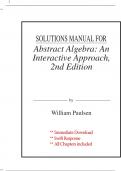solutions MANUAL FOR
Abstract Algebra: An
Interactive Approach,
2nd Edition
by
William Paulsen
** Immediate Download
** Swift Response
** All Chapters included
,Answers to Even-Numbered
Problems
Section 0.1
2) q = 15, r = 12
4) q = −21, r = 17
6) q = 87, r = 67
8) q = −1, r = 215
10) 1 + n < 1 + (n − 1)2 = n2 + 2(1 − n) < n2
12) If (n − 1)2 + 3(n − 1) + 4 = 2k, then n2 + 3n + 4 = 2(k + n + 1).
14) If 4n−1 − 1 = 3k, then 4n − 1 = 3(4k + 1).
16) (1 + x)n = (1 + x)(1 + x)n−1 ≥ (1 + x)(1 + (n − 1)x) = 1 + nx + x2 (n − 1) ≥
1 + nx
18) (n − 1)2 + (2n − 1) = n2 .
20) (n − 1)2 ((n − 1) + 1)2 /4 + n3 = n2 (n + 1)2 /4.
22) (n − 1)/((n − 1) + 1) + 1/(n(n + 1)) = n/(n + 1).
24) 4 · 100 + (−11) · 36 = 4.
26) (−6) · 464 + 5 · 560 = 16.
28) (−2) · 465 + 9 · 105 = 15.
30) (−54) · (487) + (−221) · (−119) = 1.
32) Let c = gcd(a, b). Then c is the smallest positive element of the set A =
all integers of the form au + bv. If we multiply all element of A by d, we get
the set of all integers of the form dau + dbv, and the smallest positive element
of this set would be dc. Thus, gcd(da, db) = dc.
34) Since both x/gcd(x, y) and y/gcd(x, y) are both integers, we see that
(x · y)/gcd(x, y) is a multiple of both x and y. If lcm(x, y) = ax = by is
smaller then (x · y)/gcd(x, y), then (x · y)/lcm(x, y) would be greater than
gcd(x, y). Yet (x · y)/lcm(x, y) = y/a = x/b would be a divisor of both x and
y.
36) 2 · 3 · 23 · 29.
38) 7 · 29 · 31.
40) 3 · 132 · 101.
42) u = −222222223, v = 1777777788.
44) 34 · 372 · 3336672 .
Section 0.2
2) If a/b = c/d, so that ad = bc, then ab(c2 +d2 ) = abc2 +abd2 = a2 cd+b2 cd =
cd(a2 + b2 ). Thus, ab/(a2 + b2 ) = cd/(c2 + d2 ).
4) a) One-to-one, 3x + 5 = 3y + 5 ⇒ x = y. b) Onto, f ((y − 5)/3) = y.
6) a) One-to-one, x/3 − 2/5 = y/3 − 2/5 ⇒ x = y. b) Onto, f (3y + 6/5) = y.
1
, 2 Answers to Even-Numbered Problems
8) a) One-to-one, if x > 0, y < 0 then y = 3x > 0. b) Onto, if y ≥ 0,
f (y/3) = y. If y < 0, f (y) = y.
10) a) Not one-to-one f (1) = f (2) = 1. b) Onto, f (2y − 1) = y.
12) a) One-to-one, if x even, y odd, then y = 2x + 2 is even. b) Not onto,
f (x) ̸= 3.
14) a) Not one-to-one f (5) = f (8) = 24. b) Not onto, f (x) ̸= 1.
16) Suppose f were one-to-one, and let B̃ = f (A), so that f˜ : A → B̃ would
be a bijection. By lemma 0.5, |A| = |B̃|, but |B̃| ≤ |B| < |A|.
18) Suppose f were not one-to-one. Then there is a case where f (a1 ) = f (a2 ),
and we can consider the set à = A − {a1 }, and the function f˜ : à → B would
still be onto. But |Ã| < |B| so by Problem 17 f˜ cannot be onto. Hence, f is
one-to-one.
20) x4 + 2x2 .
22) x3 − 3x{+ 2.
3x + 14 if x is even,
24) f (x) =
6x + 2 if x is odd.
26) If f (g(x)) = f (g(y)), then since f is one-to-one, g(x) = g(y). Since g is
onto, x = y.
28) There is some c ∈ C such that f (y) ̸= c for all y ∈ B. Then f (g(x)) ̸= c
since g(x) ∈ B.
30) If x even and y odd, f (x) = f{ (y) means y = x + 8 is even. Onto is proven
−1 x + 3 if x is even,
by finding the inverse: f (x) =
x − 5 if x is odd.
32) Associative, (x ∗ y) ∗ z = x ∗ (y ∗ z) = x + y + z − 2.
34) Not associative, (x ∗ y) ∗ z = x − y − z, x ∗ (y ∗ z) = x − y + z.
36) Yes.
38) Yes.
40) Yes.
42) f (x) is both one-to-one and onto.
Section 0.3
2) 55
4) 25
6) 36
8) 7
10) 10
12) 91
14) 43
16) 223
18) 73
20) 1498
22) 3617
24) 3875
26) First find 0 ≤ q ≤ u · v such that q ≡ x(mod u) and q ≡ y(mod v). Then
find k so that k ≡ q(mod u · v) and k ≡ z(mod w).
28) 12




